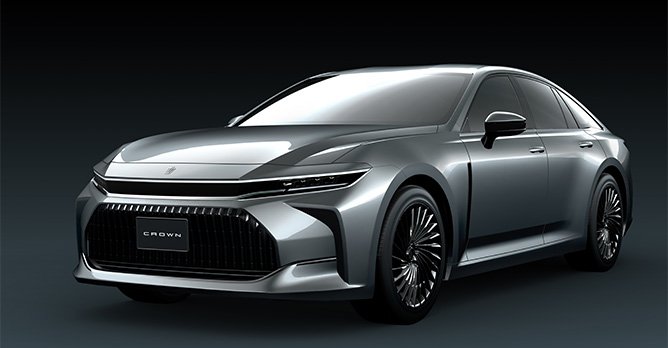Did the Toyota Crown really have to become a crossover to remain a sedan?
28 Jul 2022|11,631 views
If you can't beat 'em, join 'em.
With the SUV, that sort of rhetoric has coursed through the entire auto industry over the last decade-and-a-half, grabbing everything from budget carmakers to notoriously traditional and steely-eyed marques in its sweeping path. After years of saying 'No', 2022 alone will have seen even Lotus and Ferrari - very different performance carmakers united on their resistance until very recently - finally caving to the onslaught when it ends.
The latest member of this crowd is not surprising for who is making it, but for what it's supposed to be and stand for. When the 16th generation Crown was unveiled (fittingly) on 15 July with a montage celebrating all the generations before it, it was no longer the Toyota Crown - consummate luxury sedan - but Toyota Crowns - flagship series for the future.
There are now four body variants of the Crown. And despite the first-in-line 'Crossover' type being the sole member to hint at a high-rider in its name, only the 'Sedan' type somewhat bears the three-boxed shape we've always known - but even that's a fastback now. Don't trust the 'Sports' and 'Estate' misnomers too; both are SUVs of the modern age (acknowledged even by Toyota) with separate emphases on style and utility.
Some sympathy - and genuine acceptance?
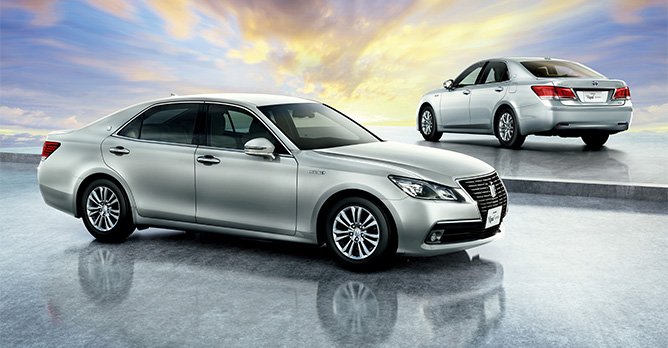
 It may be nostalgia (already) speaking, but we still prefer the Crowns of old - like our Editor's S210 Long-time fans of the Crown may be dismayed. When we covered the news, the mixed reaction skewed negative (a kinder commenter noted that the car had "Lost the majestic look"; others were harsher, slinging "Toyota Clown" and "Puik!").
It may be nostalgia (already) speaking, but we still prefer the Crowns of old - like our Editor's S210 Long-time fans of the Crown may be dismayed. When we covered the news, the mixed reaction skewed negative (a kinder commenter noted that the car had "Lost the majestic look"; others were harsher, slinging "Toyota Clown" and "Puik!").
Our Editor recently bought an S210 Crown to replace his FD2R. I asked him what he felt about this latest generation, and in particular the Crossover. His reply: "My mother once told me that if I had nothing nice to say, just shut the hell up". Gulp.
Still, consider that the Crown hasn't had the easiest journey to where it is today, and some sympathy, and in turn, genuine acceptance may be in order.
In tracing the car's history, Akio Toyoda and Hiroki Nakajima (Mid-size Vehicle, Company President) don't fail to admit that the company's domestic flagship - otherworldly Century aside - had teetered on the edge on more than one occasion.
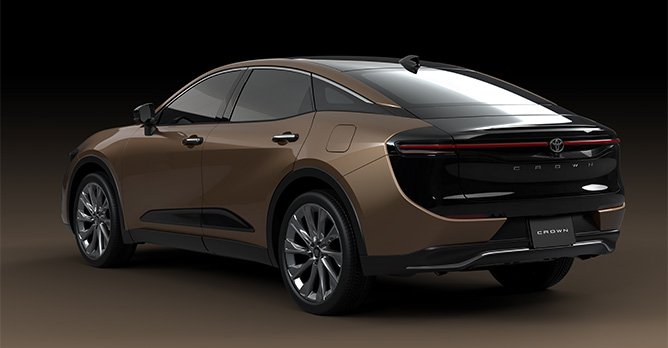
 In a new world where only a few sedans are holding strong still, the Crown is trying to diversify its appeal As evidence of its era-transcending presence, the Crown's luxury status meant that it faltered through multiple economic crises. More gravely, the sedan appears to be experiencing acceleratingly waning appeal. Efforts to rejuvenate it thus far have only stemmed the bleeding, but haven't closed the wound. In fact, that's not a wound even the most powerful manufacturers in the world can seal.
In a new world where only a few sedans are holding strong still, the Crown is trying to diversify its appeal As evidence of its era-transcending presence, the Crown's luxury status meant that it faltered through multiple economic crises. More gravely, the sedan appears to be experiencing acceleratingly waning appeal. Efforts to rejuvenate it thus far have only stemmed the bleeding, but haven't closed the wound. In fact, that's not a wound even the most powerful manufacturers in the world can seal.
In its 16th official generation, but first as a series, what we've seen is thus supposed to represent the Crown for the coming era, rooted in a "spirit of innovation and challenge". To make this one, Toyoda explains that the team threw out "fixed rules such as those governing the shape of the car or its drive system".
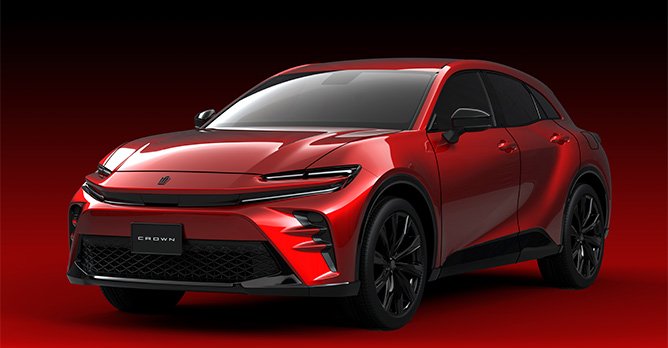
 Part of meeting a modern customer's core needs is to give them an SUV, apparently (Crown Sports pictured) One will note that Toyota talks a lot about the customer's significance when rewatching the premiere. The Crown is supposed to keep in mind their "true heart", and also meet their "core needs". And to do that for the modern customer - the one that is still driving SUVs to record sales - it needs to go beyond being just a sedan, and perhaps even just a single model.
Part of meeting a modern customer's core needs is to give them an SUV, apparently (Crown Sports pictured) One will note that Toyota talks a lot about the customer's significance when rewatching the premiere. The Crown is supposed to keep in mind their "true heart", and also meet their "core needs". And to do that for the modern customer - the one that is still driving SUVs to record sales - it needs to go beyond being just a sedan, and perhaps even just a single model.
As such, if the nameplate is supposed to represent the very best of Toyota (ignore Lexus), the Crossover, Sport and Estate should be respected as well-meaning attempts by the Japanese carmaker to bring it onto the playing field of its competitors.
Actual off-roading capabilities be damned, every single marque counts an SUV - from the BMW X7, to the Volkswagen Touareg - among its flagships. To take an objective perspective of how a dominant carmaker's lineup should be spread out is to recognise that the lack of a luxury SUV-equivalent (or equivalents) exposes a glaring hole in Toyota's game plan. The Land Cruiser doesn't quite fit this bill; neither does the Harrier, or the Highlander.
The same spirit that we've always known, under the surface-level augmentations
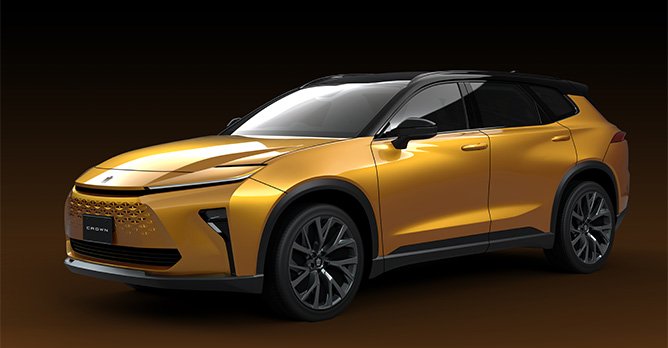
 Even premium-lite cars like the Harrier don't really exude 'flagship SUV' aura (Crown Estate pictured) As previously noted too, the mould of the raised fastback is where the industry appears to be putting its money right now. The utilitarian Crown Estate and on-trend Crown Sports aside, the Crossover is Toyota's grand effort to align with - or even put itself ahead of the competition now, with something cutting-edge and undated.
Even premium-lite cars like the Harrier don't really exude 'flagship SUV' aura (Crown Estate pictured) As previously noted too, the mould of the raised fastback is where the industry appears to be putting its money right now. The utilitarian Crown Estate and on-trend Crown Sports aside, the Crossover is Toyota's grand effort to align with - or even put itself ahead of the competition now, with something cutting-edge and undated.
Cut through the noise and the Crown's core of delivering groundbreaking technologies and authentic luxury also remains.
The V6 may be gone, but behind the flurry of discussion surrounding the Crossover's shape (and that, er, controversial rear design), the introduction of a new 2.4-litre turbo-hybrid system promises to be the latest frontier in driving refinement for the model. An inline-four turbo engine will be paired with Toyota's latest eAxle electric powertrain - also used on the bZ4X - and a newly-developed battery, providing high torque even at low revs.
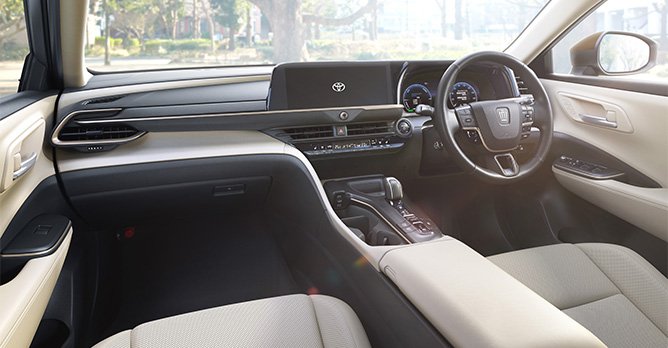
 Owners will spend most of their time inside the car, anyway - which is an indisputably welcoming space If you can stomach clicking through shots of the Crossover's exterior, you'll also be unlikely to resist the clean look of its interior, served in a delicious dual-tone colour palette. We lose some, we win some.
Owners will spend most of their time inside the car, anyway - which is an indisputably welcoming space If you can stomach clicking through shots of the Crossover's exterior, you'll also be unlikely to resist the clean look of its interior, served in a delicious dual-tone colour palette. We lose some, we win some.
But by making the Crown a series, the most important form has been given the space to remain: That of the original sedan (which is the quietly confident head-turner still, among this four-pack).
Initially set out to be canned by the product team, it was Akio Toyoda who backpedaled and suggested that the three-box shape could stay once he saw how the nameplate was being pushed to uncharted territory in the product plans presented by the team.
Crowns for the new era

 For the first time, Toyota is giving the Crown a concerted global push. The Crown Crossover, for example, will replace the Avalon in the U.S.A Sure - retain the Crown in its original form and long-time fans of the model will be pleased.
For the first time, Toyota is giving the Crown a concerted global push. The Crown Crossover, for example, will replace the Avalon in the U.S.A Sure - retain the Crown in its original form and long-time fans of the model will be pleased.
This is one of the few Toyotas to wear its own specified badge on its grille, steering wheel and trunk, after all; a legend that marked the company's (and entire domestic industry's) entry point into international rallying, and whose name has been around for nearly as long as the company itself. Among the four variants now, it's already a foregone conclusion that life on the road and behind the wheel will be most pleasant in the Sedan.
But that would have likely limited the buzz of the latest generation's premiere. For the first time ever, Toyota is also giving the Crown a strong shove beyond Japan and onto the world stage by opening it up to 40 over markets. Global sales of 200,000 units are expected annually across all four variants. Those are surely not numbers the sedan would have achieved on its own in Japan.
Above all, too, one gets the sense that had the team not ventured into deeper and riskier waters first, the sedan would have come and gone alone like the ones before it - delighting its devotees once more with its understated luxury, but ultimately failing to capture the imagination and attention of the wider world of car buyers.
We will never really love that weird fastback-SUV shape, and this entire piece is moot if you're of the opinion that the Crown should remain exclusive. But there's no doubt that in ensuring its continuity, Toyota's longest running nameplate had to become a crossover to remain a sedan.
It had to be reinvented so that it could go beyond survival to actually thrive.
One just hopes that Toyota remembers where and how the badge started. Someday, a Crown? So long as the Sedan is still there.
Slightly disturbed but intrigued nonetheless by the Crown and the general SUV trend? These articles may interest you:
Trust me, you don't really need an SUV
Is the SUV era slowly on its way out?
6 SUVs whose one-of-a-kind designs make them stand out
I bought a new car... and I sort of feel like...
With the SUV, that sort of rhetoric has coursed through the entire auto industry over the last decade-and-a-half, grabbing everything from budget carmakers to notoriously traditional and steely-eyed marques in its sweeping path. After years of saying 'No', 2022 alone will have seen even Lotus and Ferrari - very different performance carmakers united on their resistance until very recently - finally caving to the onslaught when it ends.
The latest member of this crowd is not surprising for who is making it, but for what it's supposed to be and stand for. When the 16th generation Crown was unveiled (fittingly) on 15 July with a montage celebrating all the generations before it, it was no longer the Toyota Crown - consummate luxury sedan - but Toyota Crowns - flagship series for the future.
There are now four body variants of the Crown. And despite the first-in-line 'Crossover' type being the sole member to hint at a high-rider in its name, only the 'Sedan' type somewhat bears the three-boxed shape we've always known - but even that's a fastback now. Don't trust the 'Sports' and 'Estate' misnomers too; both are SUVs of the modern age (acknowledged even by Toyota) with separate emphases on style and utility.
Some sympathy - and genuine acceptance?

Our Editor recently bought an S210 Crown to replace his FD2R. I asked him what he felt about this latest generation, and in particular the Crossover. His reply: "My mother once told me that if I had nothing nice to say, just shut the hell up". Gulp.
Still, consider that the Crown hasn't had the easiest journey to where it is today, and some sympathy, and in turn, genuine acceptance may be in order.
In tracing the car's history, Akio Toyoda and Hiroki Nakajima (Mid-size Vehicle, Company President) don't fail to admit that the company's domestic flagship - otherworldly Century aside - had teetered on the edge on more than one occasion.

In its 16th official generation, but first as a series, what we've seen is thus supposed to represent the Crown for the coming era, rooted in a "spirit of innovation and challenge". To make this one, Toyoda explains that the team threw out "fixed rules such as those governing the shape of the car or its drive system".

As such, if the nameplate is supposed to represent the very best of Toyota (ignore Lexus), the Crossover, Sport and Estate should be respected as well-meaning attempts by the Japanese carmaker to bring it onto the playing field of its competitors.
Actual off-roading capabilities be damned, every single marque counts an SUV - from the BMW X7, to the Volkswagen Touareg - among its flagships. To take an objective perspective of how a dominant carmaker's lineup should be spread out is to recognise that the lack of a luxury SUV-equivalent (or equivalents) exposes a glaring hole in Toyota's game plan. The Land Cruiser doesn't quite fit this bill; neither does the Harrier, or the Highlander.
The same spirit that we've always known, under the surface-level augmentations

Cut through the noise and the Crown's core of delivering groundbreaking technologies and authentic luxury also remains.
The V6 may be gone, but behind the flurry of discussion surrounding the Crossover's shape (and that, er, controversial rear design), the introduction of a new 2.4-litre turbo-hybrid system promises to be the latest frontier in driving refinement for the model. An inline-four turbo engine will be paired with Toyota's latest eAxle electric powertrain - also used on the bZ4X - and a newly-developed battery, providing high torque even at low revs.

But by making the Crown a series, the most important form has been given the space to remain: That of the original sedan (which is the quietly confident head-turner still, among this four-pack).
Initially set out to be canned by the product team, it was Akio Toyoda who backpedaled and suggested that the three-box shape could stay once he saw how the nameplate was being pushed to uncharted territory in the product plans presented by the team.
Crowns for the new era

This is one of the few Toyotas to wear its own specified badge on its grille, steering wheel and trunk, after all; a legend that marked the company's (and entire domestic industry's) entry point into international rallying, and whose name has been around for nearly as long as the company itself. Among the four variants now, it's already a foregone conclusion that life on the road and behind the wheel will be most pleasant in the Sedan.
But that would have likely limited the buzz of the latest generation's premiere. For the first time ever, Toyota is also giving the Crown a strong shove beyond Japan and onto the world stage by opening it up to 40 over markets. Global sales of 200,000 units are expected annually across all four variants. Those are surely not numbers the sedan would have achieved on its own in Japan.
Above all, too, one gets the sense that had the team not ventured into deeper and riskier waters first, the sedan would have come and gone alone like the ones before it - delighting its devotees once more with its understated luxury, but ultimately failing to capture the imagination and attention of the wider world of car buyers.
We will never really love that weird fastback-SUV shape, and this entire piece is moot if you're of the opinion that the Crown should remain exclusive. But there's no doubt that in ensuring its continuity, Toyota's longest running nameplate had to become a crossover to remain a sedan.
It had to be reinvented so that it could go beyond survival to actually thrive.
One just hopes that Toyota remembers where and how the badge started. Someday, a Crown? So long as the Sedan is still there.
Slightly disturbed but intrigued nonetheless by the Crown and the general SUV trend? These articles may interest you:
Trust me, you don't really need an SUV
Is the SUV era slowly on its way out?
6 SUVs whose one-of-a-kind designs make them stand out
I bought a new car... and I sort of feel like...
If you can't beat 'em, join 'em.
With the SUV, that sort of rhetoric has coursed through the entire auto industry over the last decade-and-a-half, grabbing everything from budget carmakers to notoriously traditional and steely-eyed marques in its sweeping path. After years of saying 'No', 2022 alone will have seen even Lotus and Ferrari - very different performance carmakers united on their resistance until very recently - finally caving to the onslaught when it ends.
The latest member of this crowd is not surprising for who is making it, but for what it's supposed to be and stand for. When the 16th generation Crown was unveiled (fittingly) on 15 July with a montage celebrating all the generations before it, it was no longer the Toyota Crown - consummate luxury sedan - but Toyota Crowns - flagship series for the future.
There are now four body variants of the Crown. And despite the first-in-line 'Crossover' type being the sole member to hint at a high-rider in its name, only the 'Sedan' type somewhat bears the three-boxed shape we've always known - but even that's a fastback now. Don't trust the 'Sports' and 'Estate' misnomers too; both are SUVs of the modern age (acknowledged even by Toyota) with separate emphases on style and utility.
Some sympathy - and genuine acceptance?

 It may be nostalgia (already) speaking, but we still prefer the Crowns of old - like our Editor's S210 Long-time fans of the Crown may be dismayed. When we covered the news, the mixed reaction skewed negative (a kinder commenter noted that the car had "Lost the majestic look"; others were harsher, slinging "Toyota Clown" and "Puik!").
It may be nostalgia (already) speaking, but we still prefer the Crowns of old - like our Editor's S210 Long-time fans of the Crown may be dismayed. When we covered the news, the mixed reaction skewed negative (a kinder commenter noted that the car had "Lost the majestic look"; others were harsher, slinging "Toyota Clown" and "Puik!").
Our Editor recently bought an S210 Crown to replace his FD2R. I asked him what he felt about this latest generation, and in particular the Crossover. His reply: "My mother once told me that if I had nothing nice to say, just shut the hell up". Gulp.
Still, consider that the Crown hasn't had the easiest journey to where it is today, and some sympathy, and in turn, genuine acceptance may be in order.
In tracing the car's history, Akio Toyoda and Hiroki Nakajima (Mid-size Vehicle, Company President) don't fail to admit that the company's domestic flagship - otherworldly Century aside - had teetered on the edge on more than one occasion.

 In a new world where only a few sedans are holding strong still, the Crown is trying to diversify its appeal As evidence of its era-transcending presence, the Crown's luxury status meant that it faltered through multiple economic crises. More gravely, the sedan appears to be experiencing acceleratingly waning appeal. Efforts to rejuvenate it thus far have only stemmed the bleeding, but haven't closed the wound. In fact, that's not a wound even the most powerful manufacturers in the world can seal.
In a new world where only a few sedans are holding strong still, the Crown is trying to diversify its appeal As evidence of its era-transcending presence, the Crown's luxury status meant that it faltered through multiple economic crises. More gravely, the sedan appears to be experiencing acceleratingly waning appeal. Efforts to rejuvenate it thus far have only stemmed the bleeding, but haven't closed the wound. In fact, that's not a wound even the most powerful manufacturers in the world can seal.
In its 16th official generation, but first as a series, what we've seen is thus supposed to represent the Crown for the coming era, rooted in a "spirit of innovation and challenge". To make this one, Toyoda explains that the team threw out "fixed rules such as those governing the shape of the car or its drive system".

 Part of meeting a modern customer's core needs is to give them an SUV, apparently (Crown Sports pictured) One will note that Toyota talks a lot about the customer's significance when rewatching the premiere. The Crown is supposed to keep in mind their "true heart", and also meet their "core needs". And to do that for the modern customer - the one that is still driving SUVs to record sales - it needs to go beyond being just a sedan, and perhaps even just a single model.
Part of meeting a modern customer's core needs is to give them an SUV, apparently (Crown Sports pictured) One will note that Toyota talks a lot about the customer's significance when rewatching the premiere. The Crown is supposed to keep in mind their "true heart", and also meet their "core needs". And to do that for the modern customer - the one that is still driving SUVs to record sales - it needs to go beyond being just a sedan, and perhaps even just a single model.
As such, if the nameplate is supposed to represent the very best of Toyota (ignore Lexus), the Crossover, Sport and Estate should be respected as well-meaning attempts by the Japanese carmaker to bring it onto the playing field of its competitors.
Actual off-roading capabilities be damned, every single marque counts an SUV - from the BMW X7, to the Volkswagen Touareg - among its flagships. To take an objective perspective of how a dominant carmaker's lineup should be spread out is to recognise that the lack of a luxury SUV-equivalent (or equivalents) exposes a glaring hole in Toyota's game plan. The Land Cruiser doesn't quite fit this bill; neither does the Harrier, or the Highlander.
The same spirit that we've always known, under the surface-level augmentations

 Even premium-lite cars like the Harrier don't really exude 'flagship SUV' aura (Crown Estate pictured) As previously noted too, the mould of the raised fastback is where the industry appears to be putting its money right now. The utilitarian Crown Estate and on-trend Crown Sports aside, the Crossover is Toyota's grand effort to align with - or even put itself ahead of the competition now, with something cutting-edge and undated.
Even premium-lite cars like the Harrier don't really exude 'flagship SUV' aura (Crown Estate pictured) As previously noted too, the mould of the raised fastback is where the industry appears to be putting its money right now. The utilitarian Crown Estate and on-trend Crown Sports aside, the Crossover is Toyota's grand effort to align with - or even put itself ahead of the competition now, with something cutting-edge and undated.
Cut through the noise and the Crown's core of delivering groundbreaking technologies and authentic luxury also remains.
The V6 may be gone, but behind the flurry of discussion surrounding the Crossover's shape (and that, er, controversial rear design), the introduction of a new 2.4-litre turbo-hybrid system promises to be the latest frontier in driving refinement for the model. An inline-four turbo engine will be paired with Toyota's latest eAxle electric powertrain - also used on the bZ4X - and a newly-developed battery, providing high torque even at low revs.

 Owners will spend most of their time inside the car, anyway - which is an indisputably welcoming space If you can stomach clicking through shots of the Crossover's exterior, you'll also be unlikely to resist the clean look of its interior, served in a delicious dual-tone colour palette. We lose some, we win some.
Owners will spend most of their time inside the car, anyway - which is an indisputably welcoming space If you can stomach clicking through shots of the Crossover's exterior, you'll also be unlikely to resist the clean look of its interior, served in a delicious dual-tone colour palette. We lose some, we win some.
But by making the Crown a series, the most important form has been given the space to remain: That of the original sedan (which is the quietly confident head-turner still, among this four-pack).
Initially set out to be canned by the product team, it was Akio Toyoda who backpedaled and suggested that the three-box shape could stay once he saw how the nameplate was being pushed to uncharted territory in the product plans presented by the team.
Crowns for the new era

 For the first time, Toyota is giving the Crown a concerted global push. The Crown Crossover, for example, will replace the Avalon in the U.S.A Sure - retain the Crown in its original form and long-time fans of the model will be pleased.
For the first time, Toyota is giving the Crown a concerted global push. The Crown Crossover, for example, will replace the Avalon in the U.S.A Sure - retain the Crown in its original form and long-time fans of the model will be pleased.
This is one of the few Toyotas to wear its own specified badge on its grille, steering wheel and trunk, after all; a legend that marked the company's (and entire domestic industry's) entry point into international rallying, and whose name has been around for nearly as long as the company itself. Among the four variants now, it's already a foregone conclusion that life on the road and behind the wheel will be most pleasant in the Sedan.
But that would have likely limited the buzz of the latest generation's premiere. For the first time ever, Toyota is also giving the Crown a strong shove beyond Japan and onto the world stage by opening it up to 40 over markets. Global sales of 200,000 units are expected annually across all four variants. Those are surely not numbers the sedan would have achieved on its own in Japan.
Above all, too, one gets the sense that had the team not ventured into deeper and riskier waters first, the sedan would have come and gone alone like the ones before it - delighting its devotees once more with its understated luxury, but ultimately failing to capture the imagination and attention of the wider world of car buyers.
We will never really love that weird fastback-SUV shape, and this entire piece is moot if you're of the opinion that the Crown should remain exclusive. But there's no doubt that in ensuring its continuity, Toyota's longest running nameplate had to become a crossover to remain a sedan.
It had to be reinvented so that it could go beyond survival to actually thrive.
One just hopes that Toyota remembers where and how the badge started. Someday, a Crown? So long as the Sedan is still there.
Slightly disturbed but intrigued nonetheless by the Crown and the general SUV trend? These articles may interest you:
Trust me, you don't really need an SUV
Is the SUV era slowly on its way out?
6 SUVs whose one-of-a-kind designs make them stand out
I bought a new car... and I sort of feel like...
With the SUV, that sort of rhetoric has coursed through the entire auto industry over the last decade-and-a-half, grabbing everything from budget carmakers to notoriously traditional and steely-eyed marques in its sweeping path. After years of saying 'No', 2022 alone will have seen even Lotus and Ferrari - very different performance carmakers united on their resistance until very recently - finally caving to the onslaught when it ends.
The latest member of this crowd is not surprising for who is making it, but for what it's supposed to be and stand for. When the 16th generation Crown was unveiled (fittingly) on 15 July with a montage celebrating all the generations before it, it was no longer the Toyota Crown - consummate luxury sedan - but Toyota Crowns - flagship series for the future.
There are now four body variants of the Crown. And despite the first-in-line 'Crossover' type being the sole member to hint at a high-rider in its name, only the 'Sedan' type somewhat bears the three-boxed shape we've always known - but even that's a fastback now. Don't trust the 'Sports' and 'Estate' misnomers too; both are SUVs of the modern age (acknowledged even by Toyota) with separate emphases on style and utility.
Some sympathy - and genuine acceptance?

Our Editor recently bought an S210 Crown to replace his FD2R. I asked him what he felt about this latest generation, and in particular the Crossover. His reply: "My mother once told me that if I had nothing nice to say, just shut the hell up". Gulp.
Still, consider that the Crown hasn't had the easiest journey to where it is today, and some sympathy, and in turn, genuine acceptance may be in order.
In tracing the car's history, Akio Toyoda and Hiroki Nakajima (Mid-size Vehicle, Company President) don't fail to admit that the company's domestic flagship - otherworldly Century aside - had teetered on the edge on more than one occasion.

In its 16th official generation, but first as a series, what we've seen is thus supposed to represent the Crown for the coming era, rooted in a "spirit of innovation and challenge". To make this one, Toyoda explains that the team threw out "fixed rules such as those governing the shape of the car or its drive system".

As such, if the nameplate is supposed to represent the very best of Toyota (ignore Lexus), the Crossover, Sport and Estate should be respected as well-meaning attempts by the Japanese carmaker to bring it onto the playing field of its competitors.
Actual off-roading capabilities be damned, every single marque counts an SUV - from the BMW X7, to the Volkswagen Touareg - among its flagships. To take an objective perspective of how a dominant carmaker's lineup should be spread out is to recognise that the lack of a luxury SUV-equivalent (or equivalents) exposes a glaring hole in Toyota's game plan. The Land Cruiser doesn't quite fit this bill; neither does the Harrier, or the Highlander.
The same spirit that we've always known, under the surface-level augmentations

Cut through the noise and the Crown's core of delivering groundbreaking technologies and authentic luxury also remains.
The V6 may be gone, but behind the flurry of discussion surrounding the Crossover's shape (and that, er, controversial rear design), the introduction of a new 2.4-litre turbo-hybrid system promises to be the latest frontier in driving refinement for the model. An inline-four turbo engine will be paired with Toyota's latest eAxle electric powertrain - also used on the bZ4X - and a newly-developed battery, providing high torque even at low revs.

But by making the Crown a series, the most important form has been given the space to remain: That of the original sedan (which is the quietly confident head-turner still, among this four-pack).
Initially set out to be canned by the product team, it was Akio Toyoda who backpedaled and suggested that the three-box shape could stay once he saw how the nameplate was being pushed to uncharted territory in the product plans presented by the team.
Crowns for the new era

This is one of the few Toyotas to wear its own specified badge on its grille, steering wheel and trunk, after all; a legend that marked the company's (and entire domestic industry's) entry point into international rallying, and whose name has been around for nearly as long as the company itself. Among the four variants now, it's already a foregone conclusion that life on the road and behind the wheel will be most pleasant in the Sedan.
But that would have likely limited the buzz of the latest generation's premiere. For the first time ever, Toyota is also giving the Crown a strong shove beyond Japan and onto the world stage by opening it up to 40 over markets. Global sales of 200,000 units are expected annually across all four variants. Those are surely not numbers the sedan would have achieved on its own in Japan.
Above all, too, one gets the sense that had the team not ventured into deeper and riskier waters first, the sedan would have come and gone alone like the ones before it - delighting its devotees once more with its understated luxury, but ultimately failing to capture the imagination and attention of the wider world of car buyers.
We will never really love that weird fastback-SUV shape, and this entire piece is moot if you're of the opinion that the Crown should remain exclusive. But there's no doubt that in ensuring its continuity, Toyota's longest running nameplate had to become a crossover to remain a sedan.
It had to be reinvented so that it could go beyond survival to actually thrive.
One just hopes that Toyota remembers where and how the badge started. Someday, a Crown? So long as the Sedan is still there.
Slightly disturbed but intrigued nonetheless by the Crown and the general SUV trend? These articles may interest you:
Trust me, you don't really need an SUV
Is the SUV era slowly on its way out?
6 SUVs whose one-of-a-kind designs make them stand out
I bought a new car... and I sort of feel like...
Thank You For Your Subscription.


















